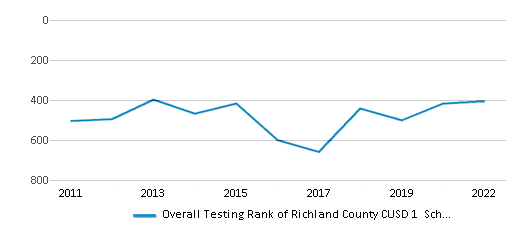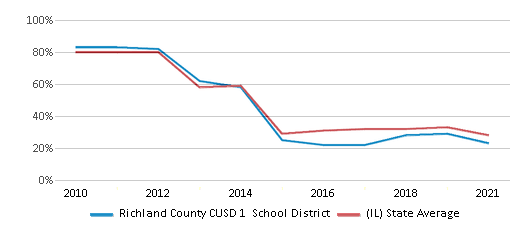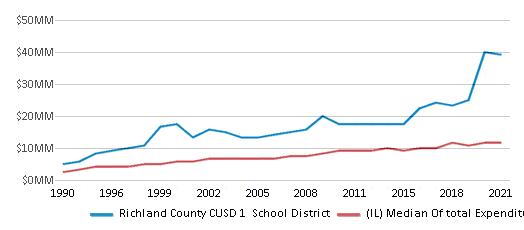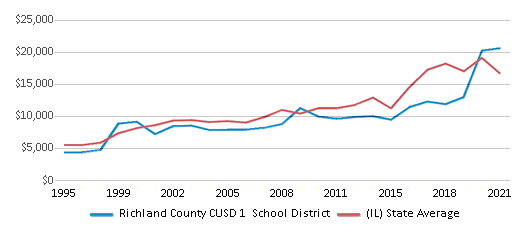For the 2025 school year, there are 2 public elementary schools serving 1,360 students in Richland County CUSD 1 School District. This district's average elementary testing ranking is 6/10, which is in the top 50% of public elementary schools in Illinois.
Public Elementary Schools in Richland County CUSD 1 School District have an average math proficiency score of 24% (versus the Illinois public elementary school average of 26%), and reading proficiency score of 30% (versus the 30% statewide average).
Minority enrollment is 8% of the student body (majority Hispanic), which is less than the Illinois public elementary school average of 56% (majority Hispanic).
Overview
This School District
This State (IL)
# Schools
4 Schools
3,104 Schools
# Students
2,182 Students
1,223,907 Students
# Teachers
144 Teachers
89,922 Teachers
Student : Teacher Ratio
15:1
15:1
District Rank
Richland County CUSD 1 School District, which is ranked within the top 50% of all 844 school districts in Illinois (based off of combined math and reading proficiency testing data) for the 2020-2021 school year.
The school district's graduation rate of 80-84% has decreased from 90-94% over five school years.
Overall District Rank
#406 out of 852 school districts
(Top 50%)
(Top 50%)

Math Test Scores (% Proficient)
(20-21)23%
28%

Reading/Language Arts Test Scores (% Proficient)
28%
30%

Science Test Scores (% Proficient)
47%
50%
Graduation Rate
80-84%
87%

Students by Ethnicity:
Diversity Score
0.16
0.71
# American Indian Students
1 Student
2,875 Students
% American Indian Students
n/a
1%
# Asian Students
12 Students
66,874 Students
% Asian Students
1%
6%
# Hispanic Students
61 Students
327,522 Students
% Hispanic Students
3%
27%
# Black Students
21 Students
200,526 Students
% Black Students
1%
17%
# White Students
1,993 Students
537,078 Students
% White Students
91%
44%
# Hawaiian Students
2 Students
1,010 Students
% Hawaiian Students
n/a
n/a
# Two or more races Students
92 Students
52,605 Students
% of Two or more races Students
4%
5%
Students by Grade:
# Students in PK Grade:
161
55,955
# Students in K Grade:
144
116,411
# Students in 1st Grade:
148
126,375
# Students in 2nd Grade:
155
167,370
# Students in 3rd Grade:
146
130,315
# Students in 4th Grade:
160
130,334
# Students in 5th Grade:
162
129,913
# Students in 6th Grade:
147
132,181
# Students in 7th Grade:
133
113,007
# Students in 8th Grade:
165
113,824
# Students in 9th Grade:
207
2,377
# Students in 10th Grade:
159
2,138
# Students in 11th Grade:
154
1,882
# Students in 12th Grade:
141
1,813
# Ungraded Students:
-
12
District Revenue and Spending
The revenue/student of $17,664 in this school district is less than the state median of $21,990. The school district revenue/student has stayed relatively flat over four school years.
The school district's spending/student of $21,482 is higher than the state median of $21,244. The school district spending/student has stayed relatively flat over four school years.
Total Revenue
$39 MM
$41,381 MM

Spending
$47 MM
$39,976 MM

Revenue / Student
$17,664
$21,990

Spending / Student
$21,482
$21,244

Best Richland County CUSD 1 School District Public Elementary Schools (2025)
School
(Math and Reading Proficiency)
(Math and Reading Proficiency)
Location
Grades
Students
Rank: #11.
Richland County Elementary School
Rank:
7/
Top 50%10
1001 N Holly Rd
Olney, IL 62450
(618) 395-8540
Olney, IL 62450
(618) 395-8540
Grades: K-5
| 915 students
Rank: #22.
Richland County Middle School
Rank:
6/
Top 50%10
1099 N Van St
Olney, IL 62450
(618) 395-4372
Olney, IL 62450
(618) 395-4372
Grades: 6-8
| 445 students
Recent Articles

Year-Round Or Traditional Schedule?
Which is more appropriate for your child? A year-round attendance schedule or traditional schedule? We look at the pros and cons.

Why You Should Encourage Your Child to Join a Sports Team
Participating in team sports has a great many benefits for children, there is no doubt. In this article you will learn what those benefits are.

White Students are Now the Minority in U.S. Public Schools
Increasing birth rates among immigrant families from Asia and Central and South America, combined with lower birth rates among white families, means that for the first time in history, public school students in the United States are majority-minority. This shift in demographics poses difficulties for schools as they work to accommodate children of varying language abilities and socio-economic backgrounds.





